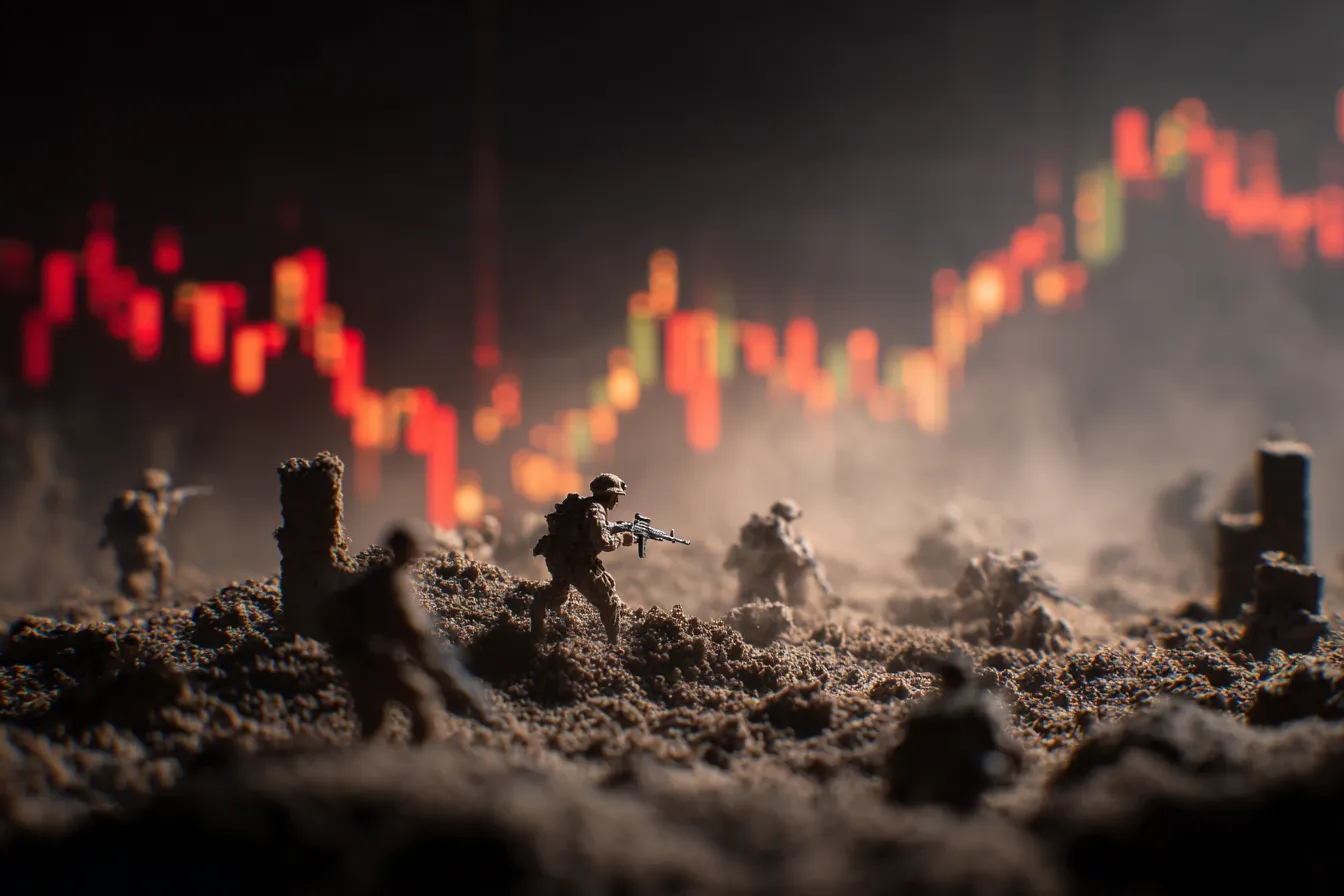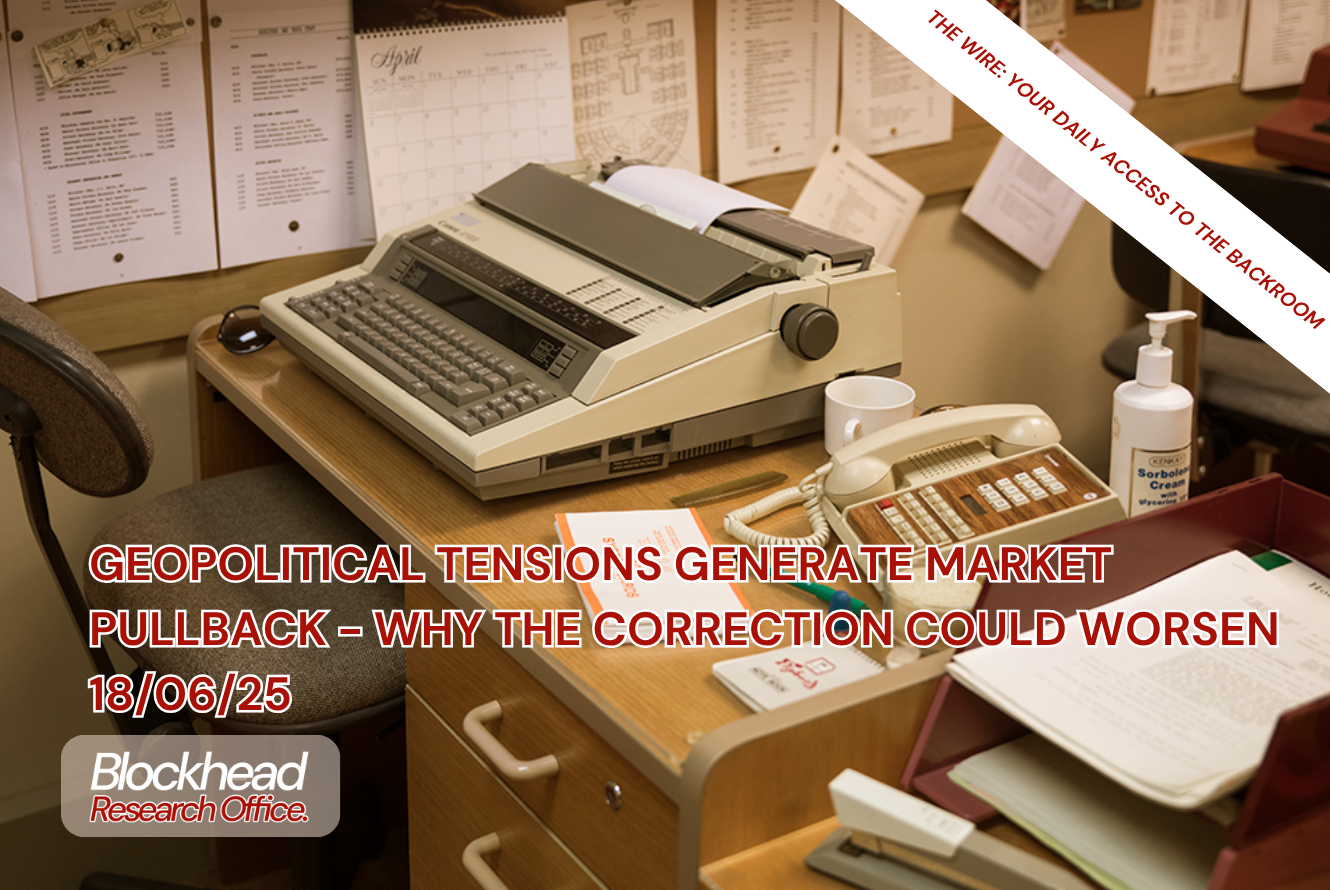Cryptos Hit: Geopolitical Risks Storm Back Into the Picture



The Israeli attack on Iran's nuclear facilities has caused oil prices to skyrocket and provided an opportunity for the dollar, which has been oversold and undervalued, to recover.
Cryptos aren't fond of energy price shocks, as the Fed has good reason to be wary because of a spike in inflation as a result.
If hostilities between Iran and Israel were to escalate further, oil prices may rise over $80, which would be good news for the dollar.
While that should have been good news for cryptos as an alternative store of value, higher oil prices also weighs on digital assets markets as it erodes the value of the currencies as a whole, whether its fiat or digital alike.
Also, with out the new information on oil price surge, the likelihood that the Fed will maintain its policy of keeping interest rates unchanged through the third quarter was already cemented.
The latest only pushes Fed's hands to stay on the sideline for a longer period.
Fed rate cuts are the next boost for cryptos, which have more or less factored-in other drivers like a pro-digital asset US administration.
War & Impact
Israeli military operations have targeted key Iranian nuclear and ballistic missile sites, along with high-ranking IRGC commanders and nuclear experts.
As a result, regional tensions have been further escalated as Iran has responded by launching almost 100 drones towards Israeli land. Israel has issued a state of emergency proclamation, describing the strikes as preventative and announcing the possibility of additional operations.
Although the United States has stayed out of it, Iran has accused Washington of being involved and may go after American assets in the area.
It appears that the US-led nuclear discussions, which had previously limited Israeli action, have come to a standstill.
Critical chokepoints for global oil and LNG commerce, the Persian Gulf, and the Strait of Hormuz have also seen an increase in marine security hazards.
Despite the fact that energy infrastructure has not been specifically targeted as of yet, there is a real concern that future strikes could disrupt supply lines, leading to even higher costs.
Should Tehran decide that a blockade is an effective means of reprisal that avoids direct targeting of US installations in the region, any limitations on maritime traffic are likely to have longer-term consequences.
Impact on Oil & Broader Markets
Energy markets have priced in a substantial risk premium due to the potential for supply interruptions caused by the elevated level of geopolitical uncertainty.
Although markets, including cryptos have somewhat recouped some of the gains, oil prices initially surged 13% due to the strikes on Iran.
BRN anticipates the rally to persist in fading unless there are concrete obstacles to the flow of Iranian oil.
Brent will likely trade between $65 and $75 in the near future because of the market's requirement to price in a higher risk premium compared to pre-attack levels, at least in the near run.
Price support will be greater in the event of an escalation that interrupts oil shipments from Iran. Around 3.3 million barrels of crude oil per day are produced by Iran, with approximately 1.7 million barrels of oil being exported.
The anticipated surplus for the fourth quarter of this year would be wiped entirely if this export supply were to disappear, and oil prices would soar towards $80/bbl.
But we think prices will level out at between $75 and $80/bbl. If there are any interruptions in the supply, OPEC could quickly restore this supply to the market because they have 5 million barrels per day of reserve production capability.
Economic Impact & Central Banks' Action
Although US inflation has been less severe than anticipated due to US tariffs, the present narrative might be upended by the recent surge in oil prices.
For cryptos, this is yet another push back looking for the Fed to restart its easing cycle after being on hold for much of this year.
2025 was predicted to be a year, where the Fed brings rates back to neutral as early as possible, instead we have seen the central bank holding back to see what happens to the economy from Trump's policies.
Price pressures in services, which make up three quarters of the core CPI basket, have started to diminish, but goods inflation has remained fairly quiet.
We doubt that will be sustained.
Companies may have been able to delay price hike decisions due to inventory buffers, but that won't last forever.
Throughout the summer, we anticipate further pronounced increases in the month-on-month inflation data.
Widespread rumors of further aggressive price hikes within three months were reported in the most recent Beige Book by the Federal Reserve. That gets worse when oil costs rise.
A rise in oil prices 10 years ago would have been seen by the Federal Reserve and other central banks as a reason to lower interest rates. The risks of a temporary increase in inflation were usually exceeded by the risks of weaker GDP.
The COVID-19 pandemic, however, caused a significant shift in that line of thinking.
Inflation in Europe's service sector picked up steam in 2022, thanks to the jump in the price of natural gas and oil.
Earlier this week, similar feedback loops were warned against by officials at the Bank of England and the Federal Reserve. The BIS has cautioned central banks that ignoring supply shocks will become more difficult.
Perhaps those concerns are exaggerated. After the energy price shock of 2022 and the pandemic, the overall economic climate was favorable for inflation to accelerate.
Governments provided large amounts of fiscal stimulus in both instances to mitigate the effects, a task that is far more challenging in the current climate due to rising interest rates and unstable financial markets.
There was also a marked improvement in the job market. Every American worker had two job openings in 2022. There is now just one, and it's lower than it was before the outbreak.
There is less room for wage growth to make a comeback. The likelihood of a rate cut by the Federal Reserve in the third quarter is obviously diminished by rising oil prices.
In recent weeks, we had a sneaking suspicion that those possibilities had crumbled. However, we anticipate that tariffs' effect on inflation will start to diminish by the year's end and that disinflation in the service sector will have gained steam.
Meanwhile, sectors like unemployment will have shown the full extent of the economic damage caused by the US trade war. The Federal Reserve is expected to make its first decrease in the fourth quarter, possibly beginning with a 50 basis point cut in December. By mid-2026, rates might drop to 3.25% as a result of a series of steep cuts.
Impact on FX
The dollar has recovered some of its early week losses, thanks to developments between Israel and Iran, but it has a long way to go before it regains its losses and its global status.
The dollar has shifted its sensitivity to risk sentiment, which is affecting equities, which is preventing dollar gains.
The dollar is currently oversold and extremely discounted, but there could be additional upside potential if tensions escalate into a larger conflict and oil prices continue to climb.
The fact that the dollar's early gain was very muted is more evidence that it is no longer seen as a safe haven, and that a persistent structural negative bias is still present.
Since this is completely attributable to internal US dynamics, we do not believe that external events, such as geopolitical tensions, will be able to reverse the dollar's decline.
When signs of a de-escalation emerge, the EUR/USD pair will likely see heavy buying on price declines.
We still think the yen is the best hedge.
The FX bets suggest the wild swings in cryptos will continue, although the risk of Bitcoin falling below the $100,000-mark remains as only an off-beat bet.
Impact on Market Rates
German government bonds established their role as a safe haven asset class by beginning to outperform swaps on Thursday, a reaction to the growing tensions around Iran.
The market's initial reaction to the announcement of military attacks on Iran quickly subsided as anxieties about the potential monetary policy implications took over.
The flattening of the curve bear and the increase in shorter-dated inflation swaps are indicators of stagflationary fears.
Still, the rates market's response will probably be subdued when seen in the bigger picture. An already volatile situation is made even more so by the escalation in Iran, on top of tariff measures, US budgetary worries, and EU spending prospects.
While markets have begun to reduce the likelihood of the ECB going beyond 1.75%, they are still anticipating one additional cut from the central bank.
In terms of longer-term rates, the 10-year swap rate is still within its current range, although it did rise slightly beyond 2.5% once again.
Credit Market Impact Reflects Crypto Worries
Credit markets have taken in and paid no attention to any worrying outside influences. Spreads have narrowed dramatically, reaching some of the narrowest levels this year, as a result of abundant liquidity removing a large amount of supply.
That shows why crypto markets seem to be worried more about the geopolitics this time around.
Credit spreads should remain relatively unaffected for the time being as long as these robust technicals keep pushing spreads and external variables are disregarded.
If these geopolitical concerns do not intensify, the credit market can swiftly return to its tightening trend, albeit the initial reaction is for the spread to expand slightly.
On the other hand, the corporate balance sheet is plagued by longer-term uncertainty, and margins are affected by inflation and increasing commodity costs, which is another credit negative.
Despite recent outperformance, the justification for a more protective credit stance is growing, thus it's possible that cyclical and manufacturing-related sectors will reverse their gains.
Elsewhere
Blockcast
Licensed to Shill III: Understanding the MAS's Licensing Requirements
In this episode of Blockcast, host Takatoshi Shibayama discusses the recent regulatory changes in Singapore's crypto landscape with guests Hagen Rooke and Lisa J.Y. Tan. They explore the implications of the Monetary Authority of Singapore's (MAS) new licensing requirements for digital token service providers , the impact on centralized and decentralized platforms, and common misconceptions surrounding the regulations.
Blockcast is hosted by Head of APAC at Ledger, Takatoshi Shibayama . Previous episodes of Blockcast can be found here , with guests like Davide Menegaldo (Neon EVM), Jeremy Tan (Singapore parliament candidate), Alex Ryvkin (Rho), Hassan Ahmed (Coinbase), Sota Watanabe (Startale), Nic Young (Oh), Jacob Phillips (Lombard), Chris Yu (SignalPlus), Kathy Zhu (Mezo), Jess Zeng (Mantle), Samar Sen (Talos), Jason Choi (Tangent), Lasanka Perera (Independent Reserve), Mark Rydon (Aethir), Luca Prosperi (M^0), Charles Hoskinson (Cardano), and Yat Siu (Animoca Brands) on our recent shows.

Blockhead is a media partner of Coinfest Asia 2025. Get 20% off tickets using the code M20BLOCKHEAD at https://coinfest.asia/tickets .

JD.com Eyes Global Stablecoin Push to Transform Cross-Border Payments
The retail giant joins Asia's stablecoin licensing race as Hong Kong prepares new regulatory framewo...

Geopolitical Tensions Generate Market Pullback - Why the Correction Could Worsen
Your daily access to the backroom....

Thailand Exempts Crypto Capital Gains From Tax Through 2029
The capital gains tax exemption represents Thailand's latest effort to balance innovation promotion ...

